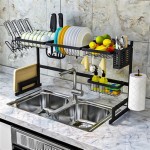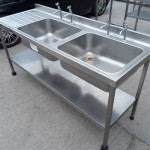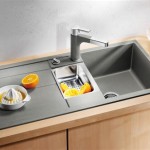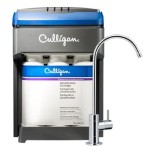Sink On Top Of Countertop: A Comprehensive Guide
The integration of a sink on top of a countertop, also known as a vessel sink or above-counter sink, represents a significant shift from traditional undermount installations. This design choice offers distinct aesthetic and practical advantages, influencing both the visual appeal and functionality of bathrooms and kitchens.
Vessel sinks elevate the sink from a functional fixture to a design centerpiece. Their prominent placement and diverse range of materials, including glass, ceramic, stone, and metal, introduce a sculptural element to the countertop. This design flexibility allows for greater personalization and stylistic expression within the space.
Beyond aesthetics, vessel sinks offer practical benefits. Their raised height eliminates the need for deep bending, improving ergonomic comfort during handwashing and other sink-related tasks. This can be particularly beneficial for individuals with mobility challenges. Installation is often simpler than undermount sinks, potentially reducing installation time and costs. The exposed rim of the vessel sink also simplifies cleaning around the sink's base.
Countertop material selection plays a critical role in the successful installation and long-term performance of vessel sinks. The countertop must be structurally sound to support the weight of the sink, especially when filled with water. Popular choices include granite, quartz, marble, concrete, and laminate. Each material offers a unique aesthetic and level of durability, requiring careful consideration based on individual needs and preferences.
Proper faucet selection is crucial for optimizing the functionality and visual harmony of a vessel sink installation. Faucet height must be carefully considered to accommodate the raised height of the sink bowl. Wall-mounted faucets, tall deck-mounted faucets, or specialized vessel faucets are common choices. The faucet's style should complement the overall design of the sink and the surrounding bathroom or kitchen decor.
Plumbing considerations are essential during the installation process. The drain assembly for a vessel sink differs from traditional sink drains. Specialized vessel sink drains are designed to accommodate the unique configuration of the above-counter basin. Ensuring proper alignment and sealing of the drain assembly is critical to prevent leaks and ensure reliable drainage.
Maintenance requirements for vessel sinks vary depending on the sink material. Glass and ceramic sinks are generally easy to clean with standard household cleaners. Stone sinks may require specialized cleaners to prevent staining and etching. Regular cleaning helps maintain the sink's appearance and prevents the buildup of mineral deposits and soap scum.
The height of the vessel sink and the countertop must be carefully coordinated to ensure ergonomic comfort and prevent back strain. The combined height should allow for comfortable handwashing and other tasks without requiring excessive bending or reaching. This is a critical factor to consider, particularly for individuals with limited mobility.
The shape and size of the vessel sink contribute significantly to the overall aesthetic and functionality of the space. Round, square, rectangular, and oval shapes are common options. Size should be determined based on the available countertop space and the intended use of the sink. Larger sinks provide ample space for washing dishes or other large items, while smaller sinks are suitable for powder rooms and other spaces with limited space.
Cost considerations for vessel sink installations can vary significantly. Factors influencing cost include the material of the sink, the complexity of the installation, and the type of faucet chosen. While some vessel sinks are more expensive than traditional undermount sinks, the simplified installation process can potentially offset some of the cost difference.
The surrounding decor and overall style of the bathroom or kitchen should be taken into account when choosing a vessel sink. The sink should complement the existing design elements, creating a cohesive and visually appealing space. Consider the color palette, the style of the cabinetry, and the other fixtures in the room when making a selection.
Accessibility considerations are important when incorporating vessel sinks, especially in public spaces or homes designed for individuals with disabilities. Ensuring adequate clearance underneath the sink and choosing a faucet that is easy to operate are essential for universal accessibility.
Integrating a vessel sink into a countertop involves careful planning and execution. Consulting with a qualified plumber and countertop installer is recommended to ensure a successful installation that meets all plumbing and building codes.
Durability and longevity are key considerations when selecting a vessel sink. The sink material should be resistant to chipping, cracking, and staining. Proper installation and regular maintenance can also extend the lifespan of the sink.
The choice between a vessel sink and a traditional undermount sink depends on individual preferences and the specific requirements of the space. Vessel sinks offer a unique aesthetic and enhanced accessibility, while undermount sinks provide a seamless and integrated look.

Pros Cons Of A Vessel Sink

Concrete Vanity Top With Integral Sink

White Black Solid Surface Stone Resin Single Bowl Bathroom Vessel Sink Above Counter Table Top Round Countertop Wash Basin Sanitaryware

Live Edge Black Walnut Vanity Raw Top Countertop Floating Bathroom Kitchen Counter Etsy

Home Decorators Collection 37 In W X 22 D Engineered Solid Surface White Rectangular Single Sink Vanity Top Silver Ash Ss37r Ah The

Farmhouse Sink Installation Easy Diy Top Mount Do Dodson Designs

Kitchen Sink And Granite Countertop Ideas

Ceramic Broad Basin Bowl Sink Bathroom Drop In Countertop Washbasin Table Top Handmade Pottery Wash Stand Handcraft Etsy

Learn Installing A Countertop Sink Diy Projects Youtube

Vessel Sinks On Wood Bathroom Countertops Custom Made By Grothouse







